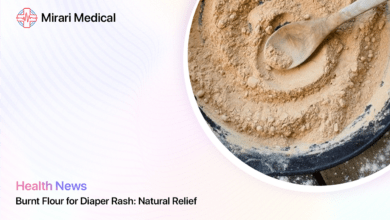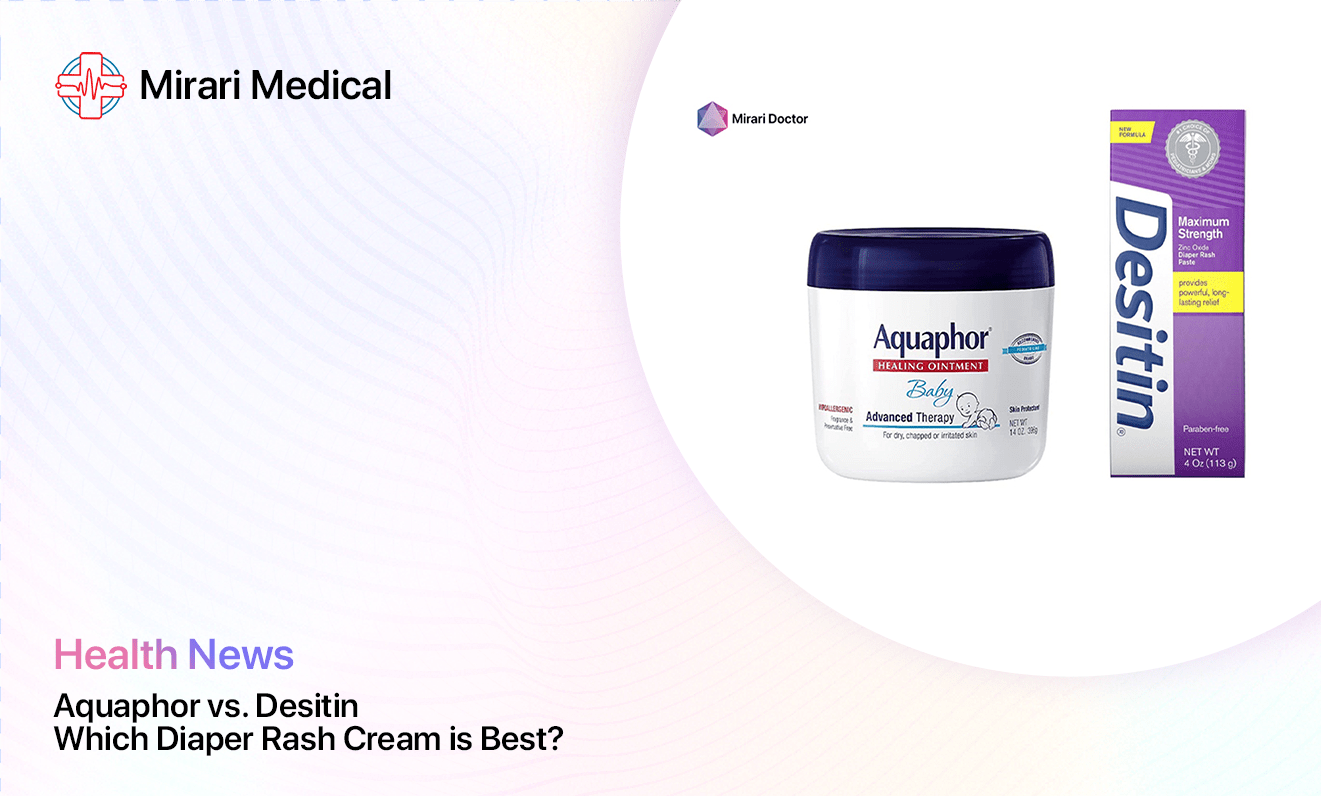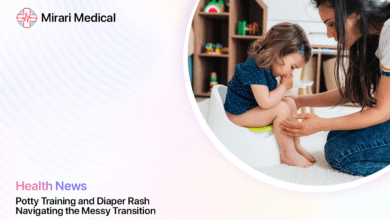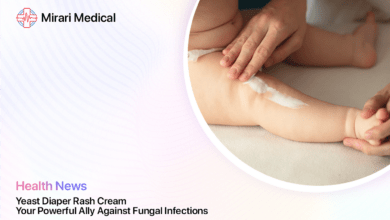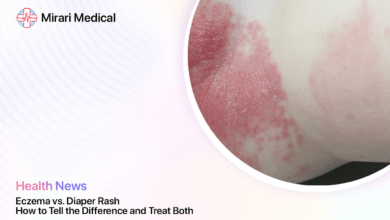Prevent Diaper Rash on Your Little Swimmer with These 10 Tips
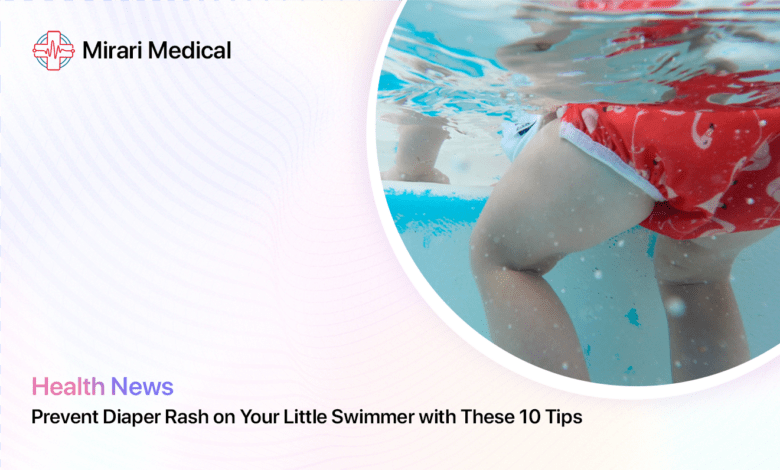
You may be interested
- Yeast Diaper Rash Cream: Your Powerful Ally Against Fungal Infections
- Diaper Rash Cream 40 Zinc Oxide: How High Concentrations Soothe Severe Rashes
- Zinc Oxide Diaper Cream: A Powerful Weapon Against Diaper Rash
- Battle of the Diaper Rash Creams: Desitin vs Aquaphor
- Potty Training and Diaper Rash: Navigating the Messy Transition
Summer is here, and that means it’s time for splashing in the pool, playing at the beach, and soaking up the sun. But for babies and toddlers still in diapers, all that water fun can sometimes lead to a not-so-fun problem: diaper rash. In fact, a whopping 50% of babies between 4 and 15 months old will experience diaper rash at some point.[1]
While swim diapers are designed to contain solid waste, they don’t absorb urine like regular diapers. This means that your little one’s sensitive skin is exposed to moisture for extended periods, which can break down the skin’s protective barrier and lead to irritation and rash. Add in the drying effects of chlorine, saltwater, and sand, and you’ve got a recipe for one unhappy bottom.
But don’t let the fear of diaper rash keep your water baby on dry land. With a few simple strategies and the right products, you can help prevent and treat swim-related diaper rash, keeping your little one comfortable and carefree all summer long. In this comprehensive guide, we’ll dive into 10 proven tips for preventing diaper rash while swimming, from choosing the right swim diaper to maintaining proper hygiene and minimizing moisture exposure. Let’s make a splash!
Choose the Right Swim Diaper
1. Opt for a Swim Diaper Designed for Water
Not all diapers are created equal when it comes to water play. Regular disposable diapers and even some cloth diapers will quickly become saturated and saggy in the water, leading to leaks and skin irritation. That’s why it’s important to use a swim diaper specifically designed for use in the pool or at the beach.
Swim diapers are made with materials that don’t swell up or disintegrate in water like regular diapers. They have a snug-fitting elastic waist and leg openings to contain solid waste, but they allow liquid to pass through to prevent the diaper from becoming waterlogged and heavy.
When shopping for swim diapers, you have two main options: disposable or reusable. Disposable swim diapers, like Huggies Little Swimmers or Pampers Splashers, are convenient for occasional use and can be tossed after a single wear. They often have easy-open sides for quick changes and come in fun, colorful designs.
Reusable swim diapers, on the other hand, are a more eco-friendly and cost-effective choice for frequent swimmers. Brands like i play., Beau & Belle Littles, and Nageuret offer adjustable, washable swim diapers made from stretchy, waterproof fabrics like polyester or neoprene. Some even have a built-in absorbent layer for light wetness protection.
Whichever type you choose, look for a swim diaper with a snug, comfortable fit that won’t sag or gap when wet. Avoid diapers with harsh elastics or rough seams that can chafe your baby’s delicate skin. And always pack a few extra swim diapers in your beach bag for changes on the go!
2. Select a Diaper with a Snug Fit
A properly fitting swim diaper is key to preventing leaks and minimizing skin irritation. A diaper that’s too loose can allow waste to escape into the water, while one that’s too tight can dig into your baby’s skin and cause chafing.
When trying on swim diapers, make sure you can comfortably fit one finger between the diaper and your baby’s waist and legs. The diaper should be snug but not constricting, and it shouldn’t leave red marks or indentations on the skin.
For reusable swim diapers, look for options with adjustable snaps or Velcro closures that allow you to customize the fit as your baby grows. Some brands, like Nageuret, offer a one-size-fits-most design with multiple rows of snaps to accommodate babies from 0-36 months.
If you’re using disposable swim diapers, choose the size based on your baby’s weight rather than their age. Each brand has slightly different sizing, so consult the package or website for guidance. Don’t be tempted to size up for extra absorbency – a too-big diaper will only lead to leaks and gaps.
Remember that swim diapers are not meant to be worn for extended periods out of the water. The lack of absorbency can lead to skin irritation if left on too long. Always change your baby into a regular diaper or training pants as soon as swim time is over.
By selecting a well-fitting, water-friendly swim diaper, you’ll help keep your baby’s sensitive skin protected and contained during aquatic adventures. But the right diaper is just the first step – proper hygiene and moisture management are equally important for preventing swim-related rashes.
Maintain Proper Hygiene
3. Change Swim Diapers Frequently
One of the most effective ways to prevent diaper rash while swimming is to change your baby’s swim diaper frequently. Even though swim diapers don’t absorb urine, they can still trap moisture against the skin, leading to irritation and breakdown of the skin’s natural barrier.
Aim to change your baby’s swim diaper every 30-60 minutes, or immediately after they have a bowel movement. Yes, this means you’ll likely go through several swim diapers in a single pool or beach session, but your baby’s bum will thank you!
When changing a swim diaper, always do so in a designated changing area or restroom, not poolside or on the beach. This helps prevent the spread of germs and keeps waste contained. Bring a few plastic bags for disposing of used diapers, and pack a small wet bag or plastic container for storing reusable diapers until you can wash them at home.
If you’re using disposable swim diapers, look for brands with easy-open sides or Velcro closures for quick, mess-free changes. Some parents find it helpful to layer a regular disposable diaper underneath the swim diaper for added absorbency and ease of changing.
For reusable swim diapers, consider bringing a few spare diaper covers or waterproof pants to rotate between changes. This allows one set to dry while the other is in use, reducing the risk of chafing from a wet diaper.
Frequent diaper changes are especially important for babies with sensitive skin or a history of diaper rash. By keeping the diaper area as dry and clean as possible, you’ll help prevent the warm, moist environment that allows bacteria and yeast to thrive.
4. Wash the Diaper Area Thoroughly
In addition to frequent diaper changes, it’s important to cleanse your baby’s diaper area thoroughly after each swim session. Chlorine, saltwater, sand, and other irritants can linger on the skin, leading to dryness, itching, and rash.
To wash your baby’s bottom after swimming, start by gently rinsing the area with clean, warm water. If you’re at a public pool or beach, use a water bottle or portable rinse kit to avoid using harsh or contaminated tap water. Pay special attention to any creases or folds in the skin where irritants can accumulate.
If your baby has visible dirt, sand, or stool on their skin, use a mild, fragrance-free cleanser to remove it. Look for products specifically designed for babies’ delicate skin, like Cetaphil Baby Gentle Wash or Aveeno Baby Cleansing Therapy Wash. Avoid using regular soap or adult cleansers, which can be too drying or irritating.
After cleansing, gently pat your baby’s skin dry with a soft towel or let it air dry completely before putting on a fresh diaper. Avoid rubbing or scrubbing the skin, which can cause further irritation.
If your baby has a pre-existing diaper rash or shows signs of irritation after swimming, you may want to apply a thin layer of a barrier cream like Desitin, Boudreaux’s Butt Paste, or Aquaphor to the affected areas before diapering. These products help soothe and protect the skin from further exposure to irritants.
By taking the time to properly cleanse and dry your baby’s diaper area after each swim, you’ll help remove any lingering irritants and create a clean, dry environment for the skin to heal and regenerate. This simple step can go a long way in preventing and treating swim-related diaper rash.
5. Dry the Area Completely
After washing your baby’s diaper area, it’s crucial to ensure the skin is completely dry before putting on a fresh diaper. Moisture is one of the main culprits behind diaper rash, as it can break down the skin’s protective barrier and create a breeding ground for bacteria and yeast.
If possible, let your baby’s bottom air dry for a few minutes before diapering. Lay them on a clean towel or changing pad, and give their skin some time to breathe. This is especially important if you’re using reusable swim diapers, which may hold onto moisture more than disposables.
If you’re in a hurry or dealing with a squirmy baby, use a soft, absorbent towel to gently pat the skin dry. Look for towels made from natural, hypoallergenic materials like cotton or bamboo, which are less likely to irritate sensitive skin. Avoid using rough or abrasive fabrics like wool or polyester.
When drying, pay close attention to any creases or folds in the skin, such as the groin, thighs, and buttocks. These areas are prone to trapping moisture and are common sites for diaper rash. Use a soft, clean washcloth or cotton swab to gently remove any remaining water or debris.
If your baby has a pre-existing diaper rash or sensitive skin, you may want to use a hair dryer on a low, cool setting to help speed up the drying process. Hold the dryer at least 6 inches away from the skin, and keep it moving to avoid overheating any one area.
Once your baby’s skin is completely dry, apply a thin layer of a barrier cream like zinc oxide or petroleum jelly to help protect the skin from further irritation. These products create a physical barrier between the skin and any remaining moisture or irritants, allowing the skin to heal.
By taking the time to thoroughly dry your baby’s diaper area after each swim session, you’ll help prevent the moist, warm environment that contributes to diaper rash. Combined with frequent diaper changes and gentle cleansing, this simple step can make a big difference in keeping your little swimmer’s skin healthy and rash-free.
Minimize Moisture Exposure
6. Limit Time in the Water
While it’s tempting to let your water baby splash and play for hours on end, prolonged exposure to moisture can increase the risk of diaper rash. The longer your baby’s skin is in contact with a wet swim diaper, the more likely they are to develop irritation and chafing.
To minimize moisture exposure, try to limit your baby’s time in the water to no more than 30-60 minutes at a stretch. This is especially important for younger babies or those with sensitive skin, who may be more prone to developing rash.
If you’re planning a longer pool or beach day, take frequent breaks to change your baby’s diaper and let their skin air out. Find a shaded spot or bring an umbrella to create a cool, dry area for diaper changes and rest time.
During breaks, remove your baby’s wet swim diaper and gently pat their skin dry with a soft towel. If possible, let them go diaper-free for a few minutes to allow the skin to breathe and any remaining moisture to evaporate.
If your baby shows signs of diaper rash or discomfort, it’s best to cut swim time short and focus on soothing and protecting their skin. Apply a thick layer of a barrier cream like Desitin or Boudreaux’s Butt Paste to the affected areas, and keep your baby out of the water until the rash has healed.
It’s also a good idea to avoid swimming altogether if your baby has a severe or active diaper rash. The chemicals and bacteria in pool water can further irritate and inflame the skin, making the rash worse. Wait until the rash has cleared up before resuming water play.
By limiting your baby’s time in the water and taking frequent breaks for diaper changes and air drying, you’ll help minimize the amount of moisture their delicate skin is exposed to. This, in turn, can help prevent and treat swim-related diaper rash, keeping your little one comfortable and happy during summer fun.
7. Consider a Diaper Rash Cream
Even with frequent diaper changes and proper hygiene, some babies may still be prone to developing diaper rash after swimming. If your little one seems particularly sensitive or has a history of rash, consider applying a diaper rash cream before and after swim sessions.
Diaper rash creams work by creating a protective barrier on the skin, shielding it from moisture, friction, and irritants. They typically contain ingredients like zinc oxide, petrolatum, or dimethicone, which help soothe and heal irritated skin.
When choosing a diaper rash cream for swimming, look for a thick, water-resistant formula that will stay put in the water. Some popular options include:
- Desitin Maximum Strength Diaper Rash Paste
- Boudreaux’s Butt Paste Maximum Strength
- Aquaphor Baby Healing Ointment
- A+D Original Diaper Rash Ointment
Before applying the cream, make sure your baby’s skin is clean and completely dry. Apply a thick layer to the entire diaper area, paying special attention to any creases or folds where moisture can accumulate. Use your fingers or a soft brush to gently spread the cream, being careful not to rub or irritate the skin.
If you’re using a reusable swim diaper, keep in mind that diaper rash creams can sometimes interfere with the diaper’s absorbency or cause staining. To prevent this, you can apply a thin layer of petroleum jelly or a cloth diaper-safe cream like CJ’s BUTTer before putting on the diaper.
After swimming, gently rinse off any remaining cream with warm water and pat the skin dry before applying a fresh layer. You may need to use a mild soap or cleanser to remove all traces of the cream, especially if you’re using a thick, paste-like formula.
If your baby develops a rash despite using a diaper cream, or if the rash seems to be getting worse, it’s best to take a break from swimming and consult with your pediatrician. They can help determine the cause of the rash and recommend appropriate treatment options.
By incorporating a water-resistant diaper rash cream into your swim routine, you can provide an extra layer of protection for your baby’s delicate skin. Combined with frequent diaper changes, thorough cleansing, and air drying, this simple step can help keep your little swimmer comfortable and rash-free all summer long.
Additional Tips for Prevention
8. Use a Barrier Cream
In addition to using a diaper rash cream specifically designed for swimming, it’s also a good idea to apply a barrier cream to your baby’s diaper area before and after swim sessions. Barrier creams help protect the skin from moisture, friction, and irritants, creating a physical barrier between the skin and any potential rash-causing agents.
Some popular barrier creams for diaper rash prevention include:
- Vaseline Petroleum Jelly
- Aquaphor Baby Healing Ointment
- Triple Paste Medicated Ointment
- Burt’s Bees Baby 100% Natural Diaper Rash Ointment
When applying a barrier cream, start with clean, dry skin. Use your fingers or a soft brush to apply a thick layer of the cream to the entire diaper area, including the buttocks, genitals, and any creases or folds. Don’t be afraid to use a generous amount – the goal is to create a visible barrier on the skin.
If you’re using a reusable swim diaper, keep in mind that some barrier creams can affect the diaper’s absorbency or cause staining. To prevent this, you can apply a thin layer of petroleum jelly or a cloth diaper-safe cream before putting on the diaper.
After swimming, gently rinse off any remaining cream with warm water and pat the skin dry before applying a fresh layer. You may need to use a mild soap or cleanser to remove all traces of the cream, especially if you’re using a thick, greasy formula.
It’s important to note that barrier creams should not be used as a substitute for frequent diaper changes and proper hygiene. While they can help prevent and treat diaper rash, they won’t be effective if your baby is left in a wet or soiled diaper for too long.
If your baby develops a rash despite using a barrier cream, or if the rash seems to be getting worse, it’s best to consult with your pediatrician. They can help determine the underlying cause of the rash and recommend appropriate treatment options, which may include prescription-strength creams or oral medications.
By incorporating a barrier cream into your baby’s diaper care routine, you can help protect their delicate skin from the moisture, friction, and irritants that can lead to swim-related diaper rash. When used in combination with other preventive measures like frequent diaper changes and thorough cleansing, barrier creams can be a powerful tool in keeping your little swimmer’s skin healthy and comfortable.
9. Avoid Irritating Soaps and Wipes
When it comes to preventing diaper rash, what you put on your baby’s skin is just as important as what you keep off of it. Many common baby care products, including soaps, shampoos, and wipes, contain harsh chemicals and fragrances that can irritate sensitive skin and disrupt the skin’s natural protective barrier.
To minimize the risk of irritation, it’s best to avoid using any unnecessary products on your baby’s diaper area, especially before or after swimming. When cleansing the skin, stick to plain, lukewarm water and a soft washcloth or cotton balls. If you need to use a cleanser, choose a mild, fragrance-free formula that’s specifically designed for babies’ delicate skin.
Some gentle, hypoallergenic cleansers that are safe for use on the diaper area include:
- Cetaphil Baby Gentle Wash
- Aveeno Baby Cleansing Therapy Moisturizing Wash
- Eucerin Baby Wash & Shampoo
- Vanicream Cleansing Bar
When it comes to wipes, it’s best to avoid them altogether if your baby is prone to diaper rash or has sensitive skin. Many commercial baby wipes contain alcohol, fragrances, and other irritants that can cause or worsen rashes. If you do need to use wipes, look for brands that are labeled as “sensitive” or “fragrance-free,” and avoid those with added moisturizers or scents.
Some gentle, hypoallergenic wipes that are safe for use on sensitive skin include:
- WaterWipes Original Baby Wipes
- Pampers Sensitive Water-Based Baby Diaper Wipes
- Huggies Natural Care Sensitive Baby Wipes
- Seventh Generation Free & Clear Baby Wipes
If your baby develops a rash or irritation after using a particular product, stop using it immediately and consult with your pediatrician. They can help identify any potential allergens or irritants and recommend alternative products that are safe for your baby’s skin.
By avoiding harsh, irritating soaps and wipes, you can help keep your baby’s delicate skin healthy and resilient, reducing the risk of swim-related diaper rash and other skin irritations. When in doubt, remember that less is often more when it comes to baby skincare – stick to simple, gentle products and let your baby’s skin do the rest.
10. Let the Skin Breathe
One of the most effective ways to prevent and treat diaper rash is to give your baby’s skin plenty of time to breathe. When a baby’s delicate skin is constantly covered by a diaper, it can become warm, moist, and prone to irritation and breakdown. By allowing the skin to air out regularly, you can help keep it dry, cool, and healthy.
After swimming, make sure to remove your baby’s wet or soiled diaper as soon as possible. If you’re in a public place, find a clean, private area to change your baby, such as a restroom or changing room. Avoid changing your baby on pool decks or beach towels, as these surfaces can harbor bacteria and other germs that can cause infections.
Once you’ve removed the wet diaper, take a few minutes to let your baby’s skin air dry completely before putting on a fresh diaper. Lay your baby on a clean towel or changing pad, and let them kick and play diaper-free for a bit. This will help any remaining moisture evaporate and allow the skin to cool down and breathe.
If your baby has a pre-existing diaper rash or shows signs of irritation, you may want to extend their diaper-free time even longer. Try to give them at least 10-15 minutes of air time after each swim session, or longer if possible. You can also incorporate regular diaper-free time into your daily routine, such as after baths or during tummy time.
When it’s time to put a new diaper on, choose a breathable, moisture-wicking option that will help keep your baby’s skin dry and comfortable. Some good choices include:
- Cloth diapers made from natural fibers like cotton or bamboo
- Disposable diapers with a breathable outer cover, like Huggies Little Snugglers or Pampers Swaddlers
- Hybrid diapers with a reusable outer cover and disposable inserts, like gDiapers or GroVia Hybrid
Avoid diapers that are too tight or restrictive, as this can trap moisture and heat against the skin and increase the risk of irritation. Make sure you can comfortably fit one finger between the diaper and your baby’s skin at the waist and legs.
By giving your baby’s skin plenty of opportunities to breathe and stay dry, you can help prevent and treat swim-related diaper rash and keep your little one comfortable and happy. Remember, a little fresh air goes a long way when it comes to keeping delicate skin healthy and rash-free!
Understand When to Seek Medical Attention
While most cases of diaper rash can be managed at home with proper prevention and treatment strategies, there are times when it’s important to seek medical attention. If your baby’s rash is severe, persists despite home treatment, or is accompanied by other symptoms, it’s best to consult with your pediatrician.
Some signs that it’s time to call the doctor include:
- A rash that covers a large area of the diaper region or spreads beyond the diaper area
- Blisters, pus-filled bumps, or open sores on the skin
- Bleeding or oozing from the rash
- A rash that looks bright red, swollen, or feels hot to the touch
- A fever of 100.4°F (38°C) or higher
- Persistent crying or fussiness that doesn’t improve with diaper changes or skin care
- Refusal to eat or drink, or a decrease in wet diapers
Your pediatrician can help determine the underlying cause of the rash and recommend appropriate treatment options. In some cases, they may prescribe a topical cream or ointment to help soothe and heal the skin, such as a hydrocortisone cream or an antifungal medication. If the rash is severe or doesn’t respond to topical treatments, they may recommend oral antibiotics or other medications.
It’s also important to seek medical attention if you suspect your baby may have a yeast infection or other type of fungal rash. These rashes can be more difficult to treat and may require specific antifungal medications. Signs of a yeast rash include:
- A bright red rash with a slightly raised border
- Pimple-like bumps or pustules around the edges of the rash
- Satellite lesions (small red bumps) outside the main rash area
If your baby has a history of frequent or severe diaper rashes, or if they have other health conditions that may increase their risk of skin irritation (such as eczema or psoriasis), it’s a good idea to work closely with your pediatrician to develop a personalized prevention and treatment plan. They can help you identify any potential triggers or risk factors, and recommend strategies to keep your baby’s skin healthy and comfortable.
Remember, while swim-related diaper rash is common and usually not serious, it’s always better to err on the side of caution when it comes to your baby’s health. If you have any concerns or questions about your baby’s skin, don’t hesitate to reach out to your pediatrician for guidance and support.
Conclusion
Swimming is a fun and healthy activity that offers many benefits for babies and young children, from improving physical coordination and strength to promoting social and cognitive development. However, for babies who are still in diapers, swimming can also increase the risk of developing diaper rash, a common and often painful skin irritation.
By understanding the factors that contribute to swim-related diaper rash and taking steps to prevent and treat it, you can help keep your baby’s delicate skin healthy and comfortable, so they can enjoy all the benefits of water play without discomfort or irritation.
Some key strategies for preventing and managing swim diaper rash include:
- Choosing a well-fitting, water-friendly swim diaper that will contain solid waste without trapping moisture against the skin
- Changing your baby’s diaper frequently, at least every 30-60 minutes or immediately after a bowel movement
- Washing your baby’s diaper area thoroughly with clean water and a mild, fragrance-free cleanser after each swim session
- Drying your baby’s skin completely before putting on a fresh diaper, and allowing plenty of diaper-free time for the skin to breathe
- Applying a thick layer of diaper rash cream or ointment before and after swimming to create a protective barrier on the skin
- Limiting your baby’s time in the water to no more than 30-60 minutes at a stretch, and taking frequent breaks for diaper changes and air drying
- Avoiding harsh soaps, wipes, and other products that can irritate sensitive skin, and choosing gentle, hypoallergenic options instead
By incorporating these strategies into your baby’s swim routine, you can help prevent and manage diaper rash, keeping your little one comfortable and happy in and out of the water.
Remember, every baby is different, and what works for one may not work for another. It may take some trial and error to find the right combination of products and practices that keep your baby’s skin healthy and rash-free. If you have any concerns or questions about your baby’s skin health, don’t hesitate to reach out to your pediatrician for guidance and support.
With a little preparation, prevention, and TLC, you can help your baby enjoy all the joys of swimming without the discomfort of diaper rash. So go ahead and make a splash – your little one’s bum will thank you!
Takeaways
- Swim diapers are designed to contain solid waste but do not absorb urine, which can lead to prolonged moisture exposure and increase the risk of diaper rash.
- To prevent swim-related diaper rash, choose a well-fitting swim diaper, change it frequently (every 30-60 minutes), and thoroughly clean and dry your baby’s skin after each swim session.
- Applying a thick layer of diaper rash cream or ointment before and after swimming can help create a protective barrier on the skin and prevent irritation.
- Limiting your baby’s time in the water to no more than 30-60 minutes at a stretch, and taking frequent breaks for diaper changes and air drying, can help minimize moisture exposure and reduce the risk of rash.
- Avoid using harsh soaps, wipes, or other products on your baby’s delicate skin, and choose gentle, fragrance-free options instead.
- If your baby develops a severe or persistent rash, or if the rash is accompanied by other symptoms like fever or refusal to eat, seek medical attention from your pediatrician.
FAQs
Can I use regular diaper cream on my baby’s skin before swimming?
It’s best to use a diaper rash cream or ointment that is specifically designed for use in the water, as regular creams may not provide adequate protection against moisture and irritants. Look for a thick, water-resistant formula that will stay put in the pool or ocean.
How often should I change my baby’s swim diaper?
It’s recommended to change your baby’s swim diaper every 30-60 minutes, or immediately after a bowel movement, to minimize exposure to moisture and waste. Frequent changes can help prevent skin irritation and diaper rash.
Can I use baby wipes to clean my baby’s skin after swimming?
While baby wipes can be convenient, it’s best to avoid using them on your baby’s delicate skin after swimming, as they may contain harsh chemicals or fragrances that can irritate the skin. Instead, use clean water and a soft cloth or cotton balls to gently clean the diaper area.
Is it okay to let my baby swim if they already have a diaper rash?
If your baby has a mild diaper rash, it’s generally okay to let them swim as long as you take extra precautions to protect their skin, such as using a thick layer of diaper rash cream and changing their diaper frequently. However, if the rash is severe or painful, it’s best to keep your baby out of the water until the rash has healed.
How can I tell if my baby’s diaper rash is caused by a yeast infection?
A yeast diaper rash often appears as a bright red, slightly raised rash with a clear border, and may be accompanied by pimple-like bumps or satellite lesions (small red bumps) outside the main rash area. If you suspect your baby has a yeast rash, contact your pediatrician for guidance on appropriate treatment options.
References
- Ward, D. B., Fleischer, A. B., Feldman, S. R., & Krowchuk, D. P. (2000). Characterization of diaper dermatitis in the United States. Archives of Pediatrics & Adolescent Medicine, 154(9), 943-946. https://doi.org/10.1001/archpedi.154.9.943
Your trusted source for health info, offering expert advice, news, and tips to stay healthy and informed.

